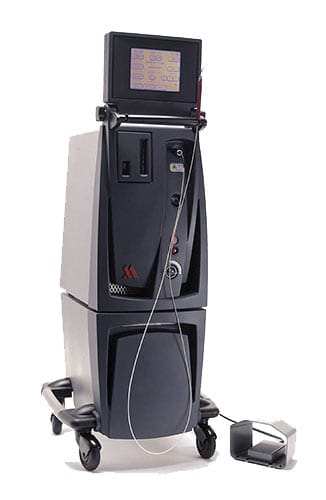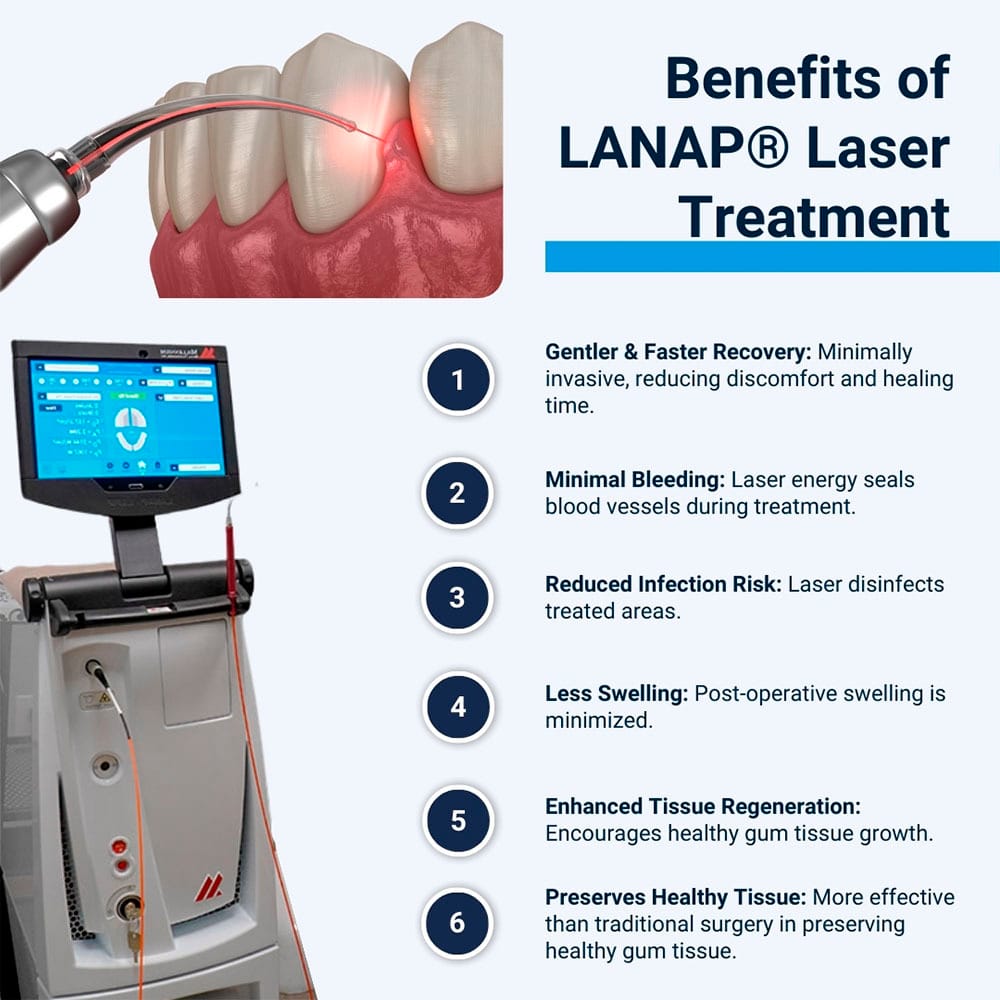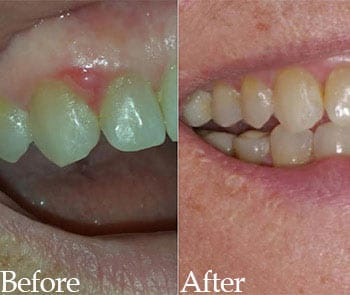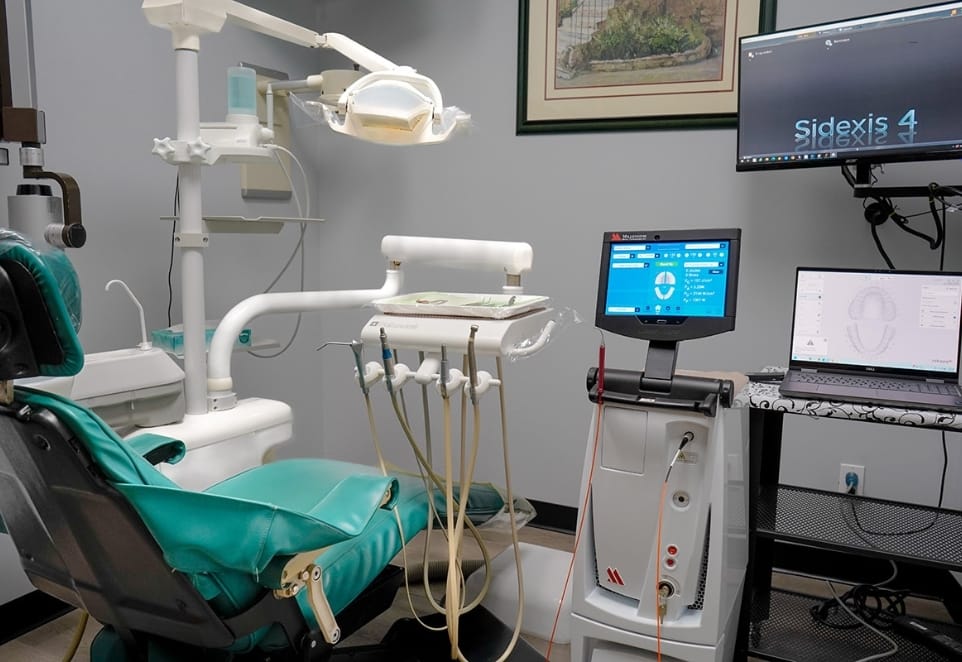What is LANAP?
 LANAP is a laser dentistry procedure that helps eliminate bacteria, enabling your gums to fight periodontal disease more effectively. LANAP laser treatment enables our dentists to precisely remove diseased gum tissue, preserving more of your healthy tissue.
LANAP is a laser dentistry procedure that helps eliminate bacteria, enabling your gums to fight periodontal disease more effectively. LANAP laser treatment enables our dentists to precisely remove diseased gum tissue, preserving more of your healthy tissue.
This procedure uses our Periolase MVP-7 dental laser. The laser energy provides a gentle and accurate treatment to help remove harmful bacteria in plaque and tartar (calculus) more thoroughly.
After cleaning your teeth, the dental laser helps us sterilize periodontal pockets, removing tissues too severely damaged to heal. Treatment creates a healthier environment where your gums can fit more snugly around your teeth, gradually reattaching.
Why Would I Need LANAP?
A dentist or periodontist at Clock Tower Dental may recommend you have this procedure if we diagnose periodontal disease.
What is Periodontal Disease?
Periodontal disease is a bacterial infection that can cause serious problems if not treated promptly. The early signs of periodontal disease, called gingivitis, are mild and easily reversible.
What are the Signs of Periodontal Disease?
You may notice bleeding when you brush or floss, or your gums look slightly swollen. However, without treatment, gingivitis can progress into moderate or more severe periodontitis.
At this point, you will likely have other symptoms such as increased bleeding, receding gums, persistent bad breath, and even teeth that start to feel loose.
As gums recede, gaps develop between your teeth and gums. These gaps are called periodontal pockets and can become quite deep. They are tricky to clean with a toothbrush and have the ideal environment for harmful bacteria to thrive.
Leaving periodontitis untreated places you at risk of tooth loss and jawbone loss. The infection can also cause other health issues as the bacteria can spread into your bloodstream through bleeding gums.
What Are the Benefits of LANAP?
The benefits of choosing this treatment can include:
- Treatment is gentler and more comfortable, so healing is faster afterward.
- Bleeding is minimal since the laser energy automatically seals or cauterizes any blood vessels during treatment.
- Infection is reduced because the laser energy helps to disinfect areas treated.
- Post-operative swelling is minimized.
- It is easier for gum tissue to regenerate afterward.
- LANAP laser treatment helps preserve more healthy gum tissue than traditional gum surgery.

Who is Suitable for LANAP?
If you are concerned about your gum health, schedule an appointment to see our periodontist, Dr. Richard Nejat, for a complete gum evaluation. If we diagnose gum disease, we can assess your suitability for laser dentistry, reviewing your medical and dental history to ensure this treatment will be safe and effective.
Our dentist will take detailed measurements around each gum using a small probe. These measurements assess the depth of any periodontal pockets. They will also need to take diagnostic images like digital dental X-rays to assess the extent of the infection and to see if it has damaged your jawbone.
If you are a smoker, you can still receive this treatment, but it will affect healing afterward. Ideally, we would prefer that you quit to ensure you receive the best treatment outcome.
The LANAP Procedure, Step-by-Step
The procedure for LANAP is as follows.
Numbing Your Gums
We will ensure this treatment is comfortable for you by numbing your gums before we begin. We can also provide sedation dentistry for anyone who feels more nervous, helping you relax in the dental chair.
Measuring the Depth of Your Periodontal Pockets
Detailed measurements are taken of your periodontal pockets. These help us to evaluate the success of treatment at follow-up appointments.
Removing Plaque and Tartar Buildup
Our dentist will ensure the laser is sent to the right wavelength to begin loosening tartar from around your tooth roots and teeth. They will also remove all infected tissues from deep inside the periodontal pockets.
Thoroughly Cleaning Your Teeth and Tooth Roots
Ultrasonic instruments are used to clean all your exposed tooth roots and tooth surfaces thoroughly. These ultrasonic tools vibrate very quickly, loosening tartar deposits so they can be flushed away harmlessly. Cleaning your teeth and tooth roots will help your gums reattach more successfully.
Disinfecting Your Gums
After cleaning your teeth, tooth roots, and periodontal pockets, our dentist will change the setting on the laser to disinfect the periodontal pockets. The process helps create a blood clot in your gums, forming a fibrin barrier that protects these treated surfaces, enabling faster healing while reducing the risk of infection.
Adjusting and Stabilizing Your Teeth
The final stage is to check how your teeth bite together and make any necessary adjustments. Ensuring your teeth bite together properly helps avoid excess stress and strain on your teeth. If your teeth are a little loose after treatment, we may splint them together to help the healing process proceed more smoothly and comfortably.
Recovery After LANAP
Before you leave our dental office, we will provide precise instructions on caring for your mouth afterward.
As the anesthetic wears off, you may feel some soreness around your gums or experience minor bleeding. Gum discoloration is also normal and can occur as your gums begin to heal.
Our dentist may prescribe an antimicrobial mouth rinse or antibiotics to help reduce the risk of infection. We are always available to answer your questions, but below are a few tips.
- Any discomfort should be minimal and easily treated with over-the-counter painkillers. These can also help reduce swelling.
- A warm salt water rinse can help soothe your mouth and aid healing. Dissolve a teaspoon of salt in a cup of warm water and gently swish it around your mouth for about 30 seconds. You can use this mouth rinse once every three hours if necessary.
- Please don’t spit for at least 24 hours afterward. Let the mouthwash fall out when rinsing your mouth rather than spitting it out.
- Don’t brush or floss around the surgery site until our dentist says it’s safe to do so.
- Continue brushing and flossing your other teeth normally.
- Choose liquid foods for the first 24 hours after LANAP laser treatment, such as smoothies and milkshakes.
- Stick to softer foods that require minimal chewing for the first week afterward.
- Don’t try to eat anything very hard or crunchy or which contains seeds or nuts. These could become stuck around the surgery site and irritate your gums.
What to Expect After Healing
 As your gums get stronger and healthier, you will notice they bleed less frequently and fit around your teeth more snugly. The size of your periodontal pockets will reduce.
As your gums get stronger and healthier, you will notice they bleed less frequently and fit around your teeth more snugly. The size of your periodontal pockets will reduce.
It can take up to a year for your gums to completely recover and for the ligaments and gum tissue to reattach and begin regenerating. During this time, you may notice your teeth and gums feeling slightly uncomfortable, which is normal. We may also need to make minor adjustments to your bite during subsequent dental visits.
You may only need one LANAP treatment, but if you have severe periodontitis, we may recommend re-treating some areas to gain optimal results.
Ongoing Dental Care After LANAP
Following a good daily oral care routine after treatment is extremely important. This will help you maintain the results more easily.
Our excellent hygiene team is here to help you improve your dental care routine if required, showing you the latest techniques and discussing the best tools to use. Your regular dental exams and hygiene appointments are also extremely important.
We recommend you have your teeth cleaned professionally every three months for the first 12 months after your LANAP procedure. After the first year, we will review the results of your LANAP laser treatment and update your ongoing dental care plan. Some people may benefit from more frequent dental cleanings for life to help control chronic periodontitis.
Why Choose Dr. Nejat if You Need LANAP® Laser Gum Therapy in Long Island?
Regarded as among the most experienced and skilled periodontists, Dr. Nejat uses the most advanced laser technology, LANAP®, minimally invasive laser treatment for moderate to severe periodontal disease (gum disease). As a board-certified periodontist, Dr. Nejat is certified by the American Board of Periodontology. With years of experience, expertise in periodontic care, and up-to-date technologies and techniques, Dr. Nejat can perform thorough assessments and treatment of gum disease. Call our Long Island team today at 516-352-1000 to set up your laser gum treatment appointment with any of our LANAP® protocol-trained dentists conveniently located in Franklin Square, Nassau County!

